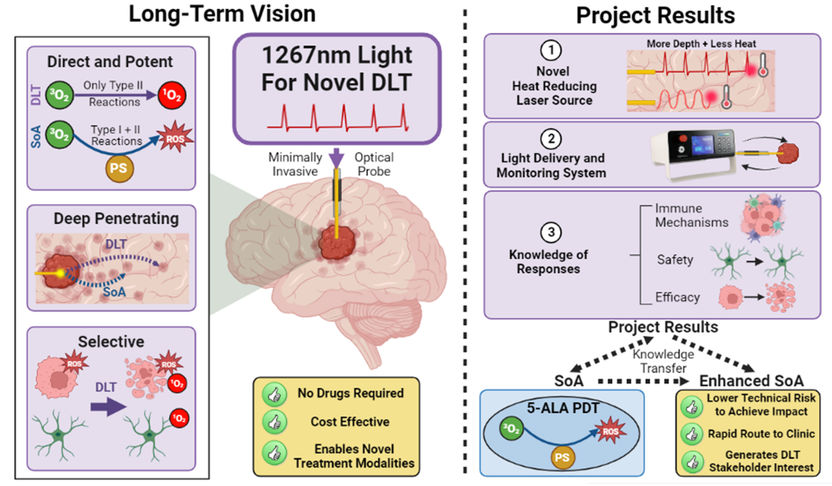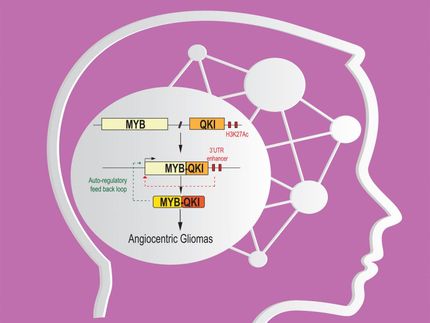EU funding for visionary glioma therapy project
Fighting brain tumors with the help of direct light therapy
Advertisement
gliomas are among the most common brain tumors. They are difficult to treat as they are diffuse and often located deep in the brain. In a new EU project, a promising, innovative method for glioma treatment is now to be investigated and prepared for clinical use. "We hope that our research will help to significantly improve the treatment of gliomas," said project coordinator Dr. Anne Régnier-Vigouroux from Johannes Gutenberg University Mainz (JGU). The project also involves the University of Aston (Birmingham) in the UK, the University of Barcelona in Spain, Ludwig Maximilian University of Munich, the Finnish laser manufacturer Modulight and Modus Research and Innovation Ltd, a non-profit British research funding consultancy. In the Pathfinder program, the European Innovation Council (EIC) supports particularly innovative, high-risk technologies in the earliest phase of their development. The partners will receive around 2.2 million euros for their GlioLighT project over the next three years.

Development of direct light therapy (DLT) as a novel glioma treatment (left) by the GlioLighT project (top right), which simultaneously improves the state-of-the-art photodynamic 5-ALA therapy (PDT) (bottom right).
©: Anne Régnier-Vigouroux
Using super-toxic singlet oxygen against gliomas
Glioma is an extremely deadly form of cancer. This is mainly due to the inaccessibility of the brain and the spread of the tumor cells. These diffuse cells are often anchored too deeply in the brain to be safely and completely removed with the treatment methods used to date - resection, radiotherapy and chemotherapy. A promising alternative is the targeted generation of reactive oxygen species - ROS for short. However, ROS can currently only be generated using photodynamic therapy, which has been tried and tested for decades but uses potentially toxic photosensitizers. To avoid the many disadvantages of this therapy, the GlioLighT partners want to take a different approach, namely direct light therapy. The reactive oxygen species are to be generated directly by laser light at a wavelength of 1267 nanometers, i.e. in the near infrared range. The light irradiation produces singlet oxygen, which destroys the cancer cells.
"If we can reach the tumour cells directly with the laser light, we can dispense with photosensitizers as amplifiers and proceed in a minimally invasive and selective manner. This would put glioma treatment on a completely new footing," says Anne Régnier-Vigouroux. The advantages would be greater efficacy and earlier intervention at lower costs. However, little is known about exactly how direct light therapy achieves its anti-cancer effect and how safe the method actually is.
Janus-faced macrophages: anti-inflammatory orientation supports tumor growth
The light also hits immune cells that are actually supposed to act against the tumor. "In Mainz, we will pay particular attention to how the light affects both tumor cells and immune cells, especially macrophages," said Régnier-Vigouroux. Macrophages are scavenger cells that can absorb pathogens and render them harmless. They can cause inflammatory reactions and thus contribute to the immune response and the fight against tumor cells, but they can also have an anti-inflammatory effect and prevent the immune system from attacking the tumor.
"Macrophages have two faces: they can actively kill tumor cells, but they can also be recruited and manipulated by the tumor cells. This can promote the growth of the tumor." According to Anne Régnier-Vigouroux, the aim is to prevent this second variant: "On the one hand, we want to eliminate the tumor cells and, on the other, induce the immune cells in the immediate vicinity to have a toxic effect on the cancer cells."
Other questions that need to be answered for GlioLighT revolve around the type of cell death that is induced and how the light affects healthy cells in the brain, such as neurons, or what dose can be used without harming healthy cells. The partners will work on novel ultrashort pulse light sources to optimize the optical penetration of the tissue and minimize the safety risk so that direct light therapy is suitable for clinical application. Ultimately, the development of the preclinical GlioLighT delivery and sensing system (pcGlio-DSS) is expected to take the improvement of glioma treatment a step further.
EIC Pathfinder for visionary and high-risk projects at an early stage of development
The project "GlioLighT - Next Generation Glioma Treatments using Direct Light Therapy" is funded under the EU framework program "Horizon Europe" and here with the future-oriented EIC Pathfinder. The total volume amounts to 2.2 million euros, of which around 770,000 euros will go to JGU as research funding. The European Innovation Council's Pathfinder program aims to identify radically new technologies that have the potential to create entirely new markets. To this end, visionary and high-risk projects are funded at an early stage of development. Applicants participating in an EIC Pathfinder project are usually visionary scientists and entrepreneurial researchers from universities, research institutions, start-ups, high-tech SMEs or industrial players interested in technological research and innovation.
Note: This article has been translated using a computer system without human intervention. LUMITOS offers these automatic translations to present a wider range of current news. Since this article has been translated with automatic translation, it is possible that it contains errors in vocabulary, syntax or grammar. The original article in German can be found here.


























































